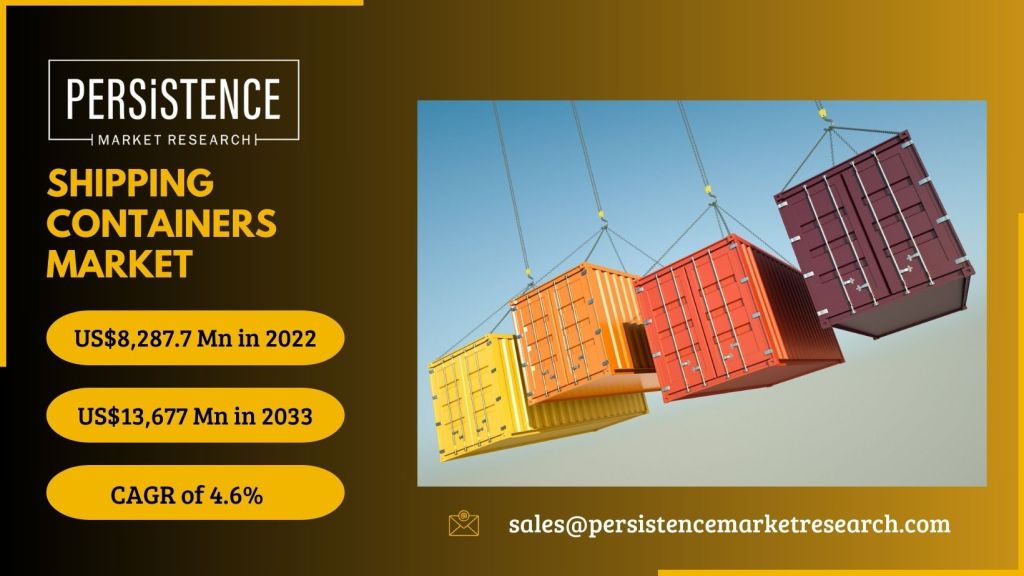Exploring Top Trends and Innovations Revolutionizing Cargo Transport
The shipping containers market is experiencing a wave of transformation, driven by innovative trends that are reshaping cargo transport. One of the prominent trends is the integration of digital technologies, such as IoT (Internet of Things) sensors and blockchain, to enhance supply chain visibility and efficiency. These technologies enable real-time tracking of cargo, ensuring timely deliveries and minimizing disruptions.
Another key trend is the development of lightweight and durable materials for container construction. Lightweight containers reduce fuel consumption and carbon emissions during transportation, contributing to sustainability efforts in the logistics industry. Additionally, advancements in container design, including foldable and collapsible containers, optimize storage space and facilitate easier handling and transportation.
The shipping containers market is experiencing significant growth, driven by globalization, international trade expansion, and the growing demand for efficient logistics solutions worldwide. Shipping containers play a vital role in facilitating the movement of goods across borders, enabling cost-effective transportation, and optimizing supply chain operations. The demand for shipping containers is expected to grow primarily due to increasing sea-borne trade activities across key countries and regions, with leading players holding a prominent share of the global shipping container market in 2024. The shipping container industry is projected to reach US$ 13,677 million by 2031, growing at a CAGR of 4.6 % from 2024 to 2031.
Market Drivers:
- Global Trade Expansion: The proliferation of global trade agreements, economic liberalization policies, and the rise of e-commerce platforms fuel the demand for shipping containers. Increasing imports and exports of goods, raw materials, and manufactured products across diverse industry sectors drive market growth, supporting international trade flows and supply chain integration.
- Containerization Efficiency: Containerization revolutionizes cargo handling, transportation, and storage processes, offering efficiency gains, cost savings, and scalability benefits for logistics operators and shipping companies. Standardized container sizes, intermodal compatibility, and efficient cargo handling infrastructure enhance operational efficiency, reducing transit times and optimizing freight logistics.
- Infrastructure Development: Infrastructure investments in port facilities, intermodal terminals, and transportation networks stimulate demand for shipping containers. Government initiatives aimed at enhancing maritime trade capabilities, expanding port capacities, and improving connectivity between production centers and consumption markets drive market growth, supporting containerized cargo traffic volumes.
Global Industry Analysis, Size, Share, Growth, Trends, and Forecast 2023-2032 – By Product Type, Application, End-user, Region: (North America, Europe, Asia Pacific, Latin America and Middle East and Africa): https://www.persistencemarketresearch.com/market-research/shipping-containers-market.asp
Market Restraints:
- Volatility in Shipping Rates: Fluctuations in freight rates, fuel prices, and operating costs impact the profitability of shipping container leasing and transportation companies. Market volatility, supply-demand imbalances, and geopolitical uncertainties pose challenges for industry stakeholders, influencing investment decisions, fleet expansion strategies, and pricing dynamics in the shipping containers market.
- Trade Protectionism: Trade disputes, tariffs, and protectionist measures disrupt global supply chains, affecting shipping container demand and trade volumes. Economic sanctions, trade barriers, and geopolitical tensions between major trading partners create uncertainties, trade imbalances, and market distortions, constraining international trade growth and containerized cargo traffic.
- Environmental Regulations: Stringent environmental regulations, emissions standards, and sustainability mandates pose compliance challenges for shipping container manufacturers and operators. Pressure to reduce carbon emissions, minimize environmental impact, and adopt eco-friendly practices drive investments in energy-efficient container designs, alternative propulsion technologies, and sustainable shipping practices.
Market Opportunities:
- Container Fleet Modernization: Market players can capitalize on opportunities for fleet modernization, replacement, and expansion to meet evolving customer demands and regulatory requirements. Investments in new container technologies, lightweight materials, and eco-friendly coatings enhance container durability, corrosion resistance, and environmental performance, driving fleet renewal and optimization initiatives.
- Digitalization and IoT Integration: The integration of digital technologies, IoT sensors, and telematics solutions into shipping containers enables real-time monitoring, tracking, and management of containerized cargo. Smart container systems offer visibility, transparency, and data-driven insights into cargo condition, location, and security, optimizing supply chain visibility, efficiency, and risk management.
- Multimodal Transportation Networks: Market opportunities lie in the development of integrated multimodal transportation networks, connecting maritime shipping routes with inland distribution hubs, rail networks, and intermodal terminals. Investments in last-mile connectivity, hinterland infrastructure, and seamless modal transitions enhance supply chain connectivity, reduce transit times, and mitigate logistics bottlenecks, driving demand for shipping containers as a key enabler of multimodal logistics solutions.
Market Segmentations:
Shipping container Market by product Type
- Dry Containers
- 20’ (20 ft.)
- 40’ (40 ft.)
- 40’ High Cube
- Others
- Reefer Containers
- 20’ (20 ft.)
- 40’ (40 ft.)
- 40’ High Cube
- Others
- Tank Containers
- Offshore Containers
Shipping Containers Market by Material
- Steel
- Aluminum
- FRP
- Hybrid
Shipping Containers Market by End User
- Bulk Commodity
- Automotive
- Capital Equipment
- Pharmaceuticals
- Chemicals
- Perishable and Frozen Items
- Others
By Region:
- North America
- Europe
- Asia-Pacific
- Latin America
- Middle East & Africa
Regional Market Dynamics:
North America: The North American shipping containers market is characterized by robust maritime trade, extensive port infrastructure, and a well-established logistics ecosystem. Market players focus on innovation, sustainability, and digitalization initiatives to enhance operational efficiency, mitigate environmental impact, and address evolving customer needs in a competitive market landscape.
Europe: Europe showcases a mature shipping containers market, driven by strategic location advantages, maritime connectivity, and a strong manufacturing base. Market players emphasize container fleet optimization, intermodal transport integration, and sustainability measures to align with EU transportation policies, carbon reduction targets, and environmental regulations, fostering market growth and competitiveness.
Asia-Pacific: The Asia-Pacific region emerges as a dominant market for shipping containers, fueled by rapid economic growth, rising consumer demand, and expanding trade volumes. Market players leverage Asia-Pacific’s position as a global manufacturing hub, investing in container manufacturing capacity expansion, port infrastructure development, and digitalization initiatives to meet growing demand for containerized cargo transportation and logistics services.
Key Players:
The shipping containers market features a diverse array of players, including container manufacturers, leasing companies, shipping lines, and logistics service providers. Some prominent players include:
- China International Marine Containers Co., Ltd.
- Singamas Container Holdings Limited
- CXIC Group Containers Company Limited
- Maersk Container Industry
- Sea Box, Inc.
- W&K Container
- YMC Container Solutions
- TLS Offshore Containers International
- OEG OFFSHORE LIMITED
- CARU Containers B.V.
- IWES LTD.
- Others
Market Trends & Latest Developments:
- Container Digital Twins: Adoption of container digital twins enables virtual modeling, simulation, and optimization of container operations, enhancing asset management, predictive maintenance, and cargo security in the shipping containers market.
- Blockchain-based Supply Chain Platforms: Implementation of blockchain technology in supply chain platforms offers transparency, traceability, and security benefits for containerized cargo tracking, documentation, and transaction management, reducing fraud risks and enhancing trust in global trade transactions.
- Hydrogen Fuel Cell Containers: Development of hydrogen fuel cell-powered container ships and eco-friendly container handling equipment reduces carbon emissions, environmental footprint, and reliance on fossil fuels in maritime transportation, aligning with sustainability goals and regulatory mandates in the shipping industry.
Future Trends and Outlook:
- Autonomous Container Handling: Advancements in autonomous container handling technologies enable unmanned container terminals, automated port operations, and efficient cargo handling processes, enhancing productivity, safety, and scalability in maritime logistics operations.
- Circular Economy Initiatives: Adoption of circular economy principles in container design, manufacturing, and end-of-life management promotes recycling, reuse, and remanufacturing of container materials, reducing waste generation, resource consumption, and environmental impact throughout the container lifecycle.
- Green Port Development: Green port development initiatives focus on eco-friendly port infrastructure, renewable energy integration, and emission reduction measures to create sustainable, resilient port ecosystems, supporting clean maritime transport, biodiversity conservation, and climate change mitigation efforts globally.
In conclusion, the shipping containers market presents lucrative opportunities for innovation, sustainability, and market expansion, driven by globalization, trade liberalization, and technological advancements. Market players must navigate challenges, embrace digitalization, and capitalize on emerging trends to capture growth prospects and maintain a competitive edge in the dynamic global shipping containers market landscape.
About Persistence Market Research:
Business intelligence is the foundation of every business model employed by Persistence Market Research. Multi-dimensional sources are being put to work, which include big data, customer experience analytics, and real-time data collection. Thus, working on “micros” by Persistence Market Research helps companies overcome their “macro” business challenges.
Persistence Market Research is always way ahead of its time. In other words, it tables market solutions by stepping into the companies’/clients’ shoes much before they themselves have a sneak pick into the market. The pro-active approach followed by experts at Persistence Market Research helps companies/clients lay their hands on techno-commercial insights beforehand, so that the subsequent course of action could be simplified on their part.
Contact
Persistence Market Research
Teerth Technospace, Unit B-704
Survey Number – 103, Baner
Mumbai Bangalore Highway
Pune 411045 India
Email: sales@persistencemarketresearch.com


Leave a comment